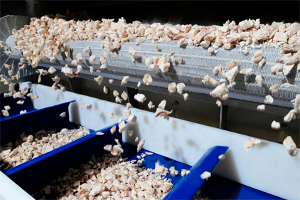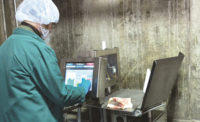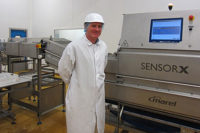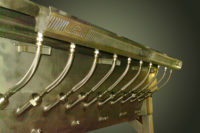Tip Top Poultry, of Marietta, Ga., is the largest baking and stewing hen marketer in the United States and a major supplier of individually quick-frozen (IQF) cooked, pulled and diced chicken meat to the foodservice and industrial market sectors.

|
Tip Top processes IQF products in Rockmart, Ga. Boiled hens are deboned, and meat is filleted, pulled or diced to size, from 1/4” to 1” and then individually quick-frozen. Diced poultry is screened and fines are packed for separate sale. In the past, diced poultry and other IQF products were fed into three or four CO2-flighted freezers, feeding two packaging lines.
Flighted freezers have been the mainstay for IQF diced poultry for more than 20 years. Yet, there are a few problems with CO2-flighted freezers, notes Curt McNiff, plant manager for Tip Top’s Rockmart facility, from freezing efficiency to exhaust and CO2 carryover. In the Rockmart plant, snow needs to be cleaned from internals, often several times a shift, and fines needs to be screened from the snow post-freeze. Both contribute to yield losses.
“With CO2, we had to use extra labor and equipment to remove the snow from the fines to pack them off. If you boxed them with the snow, you’d be looking at a [weight] shortage.”
Now, Tip Top has found a better way. Tip Top replaced two of the Rockmart plant’s three CO2-flighted freezers used to meet current production capacity with a single 8-meter (27-foot) Cryoline® CW (Cryowave) tunnel freezer, which uses nitrogen, from Linde (Murray Hill, N.J.).
“When you’re looking at automation in pack-out, if you can put IQF production all through one IQF freezer, you only have to buy one scale and one bagger. Our capacity to run it through a single system results in a reduction of operational and sanitation labor,” McNiff explains. “And at the front end, we have a manual deboning process, so if you have to stop that line for changeovers or other reasons, it becomes very costly.”
Based on its own in-plant audits and engineering assessments, Linde estimated the “cost to freeze” for converting that first line.
“Linde met all the projected targets, and the savings were substantial,” McNiff says. “They gave us a lot of support before, during and after the installation and startup. Even now, they’re at the plant, checking to make sure everything is optimum.”
With the Cryowave tunnel freezer, diced poultry is layered onto the belt two-inches deep in a continuous operation and produces almost 100% IQF high-quality product. The freezer features a patented rolling wave action that keeps products in motion — and separate — during the freeze.
“The Cryowave is less abusive to the product, utilizes less cryogen and eliminates the labor associated with CO2 snow removal,” McNiff adds.
Furthermore, he says he likes the fact that the wave is fully adjustable, and process settings can be programmed for rapid changeouts. In addition, hygienic design allows complete access to all internal surfaces for easy cleaning, now down to once a shift. Most importantly, the Cryowave cuts freeze time from 5 minutes with the CO2 freezer to about 1.5 to 3 min. maximum, with diced poultry at the lower range.
Based on performance and further in-plant engineering by Linde, Tip Top can now eliminate the third flighted freezer and move all current production to the single Cryowave tunnel simply by adding a modular extension. The extra 3-meter (9 ft. 9 in.) extension improves cryogen efficiency and also adds surge capacity to help avoid bottlenecks.





Report Abusive Comment